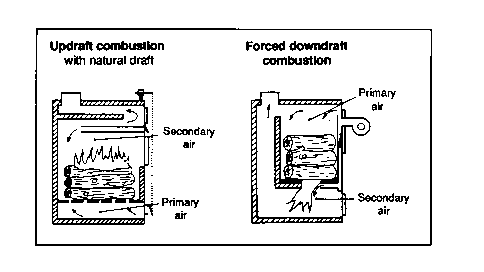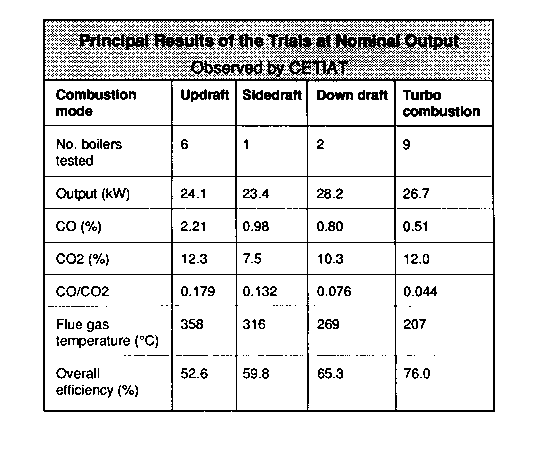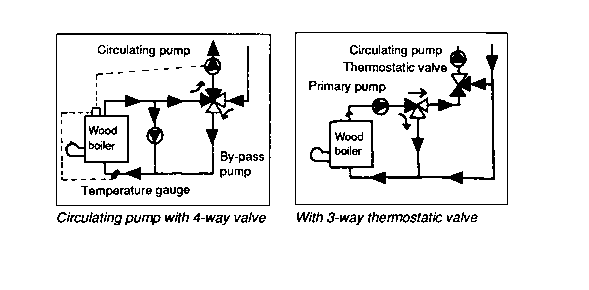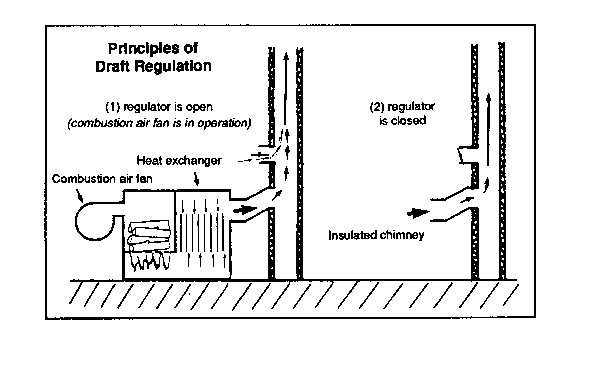
Sustainable Farming Index | Virtual Library | Magazine Rack
Search
| Ecological Solutions Roundtable
A technological leap forward . . . . with a little installation and maintenance touchiness.
In comparison with conventional updraft, side draft and downdraft boilers, the main advances in turbo combustion have been forced downdraft (using a blower or draft inducer) ensuring better control and distribution of combustion air.
Primary air introduced on top of the fuel is involved in drying the wood and in the pyrolysis/gasification process which occurs in thin layers at the grate level. Gas combustion is activated, under the grate, by the injection of secondary air into the high-temperature refractory-lined combustion chamber.
The aquastat-controlled combustion air fan (or draft inducer) has two functions:
¥ forced draft allows an increase of the heat exchange surfaces between hot gases and water jacket (longer combustion gas travel path);
¥ the on-off action matches wood combustion with energy demand.
In France, in 1990, the Centre d'Etudes Techniques des Industries AŽrauliques et Thermiques (CETIAT) performed a comparative study of 18 wood boilers (9 traditional boilers and 9 turbo boilers). The results of the tests demonstrated three improvements in the turbo combustion boilers in comparison to traditional boilers.
Improved combustion is linked to regularity of air flow (combustion air fan) and to a better match to each phase of combustion (drying, pyrolysis/gasification, gas combustion). This more complete combustion is less polluting particularly due to the four fold reduction in carbon monoxide (CO) compared to updraft boilers (Table 1).
Combustion gas temperatures drop from the 250-45¡C range for traditional boilers to the 180-250¡C range for turbo combustion systems (Table 1).
The combustion air fan, because of its ability to eliminate important load losses, enables manufacturers to better design heat exchange surfaces to increase efficiency.
In comparison to traditional boilers (updraft or downdraft), the overall efficiency is increased by 10 to 25 percentage points.
With efficiencies in the 71 to 84% range, the turbo combustion systems allow savings of 5 to 10 cubic metre (1 1/2 to 3 full cords) of wood per year; as well, they have extended firing cycles (4-8 hours, at normal output, depending on the make and model) decreasing the number of loadings in a day.
The laboratory test performance of turbo combustion systems is confirmed by users. However, corrosion (holes in the fuel chamber) has reduced the life of some heaters. The cause of these premature deteriorations are not necessarily attributed to the quality of the materials used but more to poor installation and maintenance.
Sizing the appliance to heating load must be done to obtain maximum yield at nominal output; this reduces the standby periods (combustion blower off), during which large amounts of creosote (products of pyrolysis/gasification) condense on the fuel chamber walls, causing metal corrosion.
Although the choice of a larger unit allows long burn cycles and less frequent reloading, oversizing is strongly discouraged (unless using heat storage tanks).
Manufacturers recommend that return water temperature be maintained higher than 65-70¡C in order to limit creosote deposits on boiler walls. Thus on each installation, a shunt should be included to recirculate part of the heated water back to the boiler:
¥ using a circulating pump and a four-way valve (manually operated according to heat demand), and eventually, automating the distribution pump to return water temperature.
¥ using a three-way thermostat valve, which only distributes water if the outlet temperature is higher than the set value.
Flue sizing for turbo wood boilers must meet manufacturers' instructions, particularly concerning minimum draft to be maintained at the boiler flue collar and will vary depending on chimney material when the combustion fan is operating. Three requirements must be fulfilled:
¥ Exhausting combustion products by natural draft during low-fire, when the combustion air fan is off (frequently in mild seasons and even more so for oversized installations); insufficient draft will allow a positive pressure buildup at the flue collar resulting in a flue gas buildup inside the boiler, increasing the risk of corrosion. Reducing chimney cross sectional area (250 sq.cm minimum or 7-inch round chimney) and insulating the pipes are two important factors for good natural draft in standby mode.
¥ Using a draft regulator to stabilize draft at the flue collar during combustion fan operation; strong draft will increase the combustion rate and decrease the firing cycle, calling for more frequent loading. A draft regulator is strongly recommended.
¥ Maintain flue gas temperatures high enough to prevent water and creosote condensation; this will be more easily attainable with a properly sized and well insulated chimney.
Good combustion and high efficiency are easier to obtain with low moisture wood (20 to 25% maximum); this is essential for a good-working installation. Hardwoods and conifers yield similar performance except for firing periods which will be reduced by approximately 20% with low density wood such as pine.
¥ daily ash removal
¥ weekly cleanup of the fuel chamber
¥ cleanup of heat exchange surfaces: once or twice a month
¥ yearly chimney sweep
Performance of these new systems are linked to the strict compliance to installation codes and to good operation by well-informed users. Under these conditions the turbo combustion boilers will bring uncontestable progress.
An investigation of 30 owner/operators of turbo combustion wood boilers (10 Energie Systéme, 10 Unical and 10 HS France) was performed in the French department of Orne.
Positive points:
¥ fuel savings: 30% approximately
¥ extended firing cycle: 6 to 24 hours depending on equipment *
¥ loading frequency: 1 to 4 times daily
¥ low volume of ash
¥ better house temperature control
¥ poor performance in low demand periods (problem linked to oversizing)
¥ maintenance constraints: daily ash removal, combustion chamber cleaning (varied depending on the user), chimney sweeping 2 to 3 times a year.
Since 1989, an efficient recycling system has been systematically installed and high creosote deposits have been linked to non-insulated chimneys.
* Extended firing cycles are longer than those expected by manufacturers (4 to 8 hours) because the heaters are generally oversized and the recent winters have been milder.




Copyright © 1993 REAP Canada
Reprinted with permission. All rights reserved.
Info Request | Services | Become EAP Member | Site Map
Give us your comments about the EAP site
Ecological Agriculture Projects, McGill University (Macdonald
Campus),
Ste-Anne-de-Bellevue, QC, H9X 3V9 Canada
Telephone:
(514)-398-7771
Fax:
(514)-398-7621
Email: info@eap.mcgill.ca
To report problems or otherwise comment on the structure of this site, send mail to the Webmaster